A great down jacket should serve two purposes:
- Keep you warm, and
- Look good while doing it.
But with many types of usage; from 40°F morning commutes to 20°F backpacking trips to literal sub-zero excursions, wading through the vast array of down jackets on the market is confusing.
This Complete Guide to Down Jackets is your crash course to one of the most important parts of your winter wardrobe.
We’ll kick it off with the 14 of the best down jackets available today, highlighting some key specs about each jacket and its intended best use.
Then after the rankings we’ll dive into how to choose the best down jacket for you!
But before I get too verbose, let’s name some “Quick Picks” winners if you want to get in, find your jacket, and hit the trail!
Table Of Contents
- Best Down Jackets of 2024
- 7 Best Down Jackets: Reviewed
- Canada Goose Expedition Down Parka
- Mountain Hardware Absolute Zero Down Parka
- Mountain Hardware Nilas Down Parka
- Marmot Fordham Down Jacket
- Marmot Ithaca Down Jacket
- Arc’teryx Cerium LT
- Canada Goose MacMillan Down Parka
- Fjallraven Greenland No. 1 Down Parka
- Mountain Hardware Ghost Whisperer Down Jacket
- Black Diamond Cold Forge Down Jacket
- Outdoor Research Transcendent Down Jacket
- Fjallraven Greenland Down Liner
- Patagonia Down Sweater Jacket
- Patagonia Down Vest
- Types of Down Jackets
- How to Choose the Best Down Jacket
- Natural Down vs Synthetic Down Jackets
- Down Jackets FAQ
Best Down Jackets of 2024
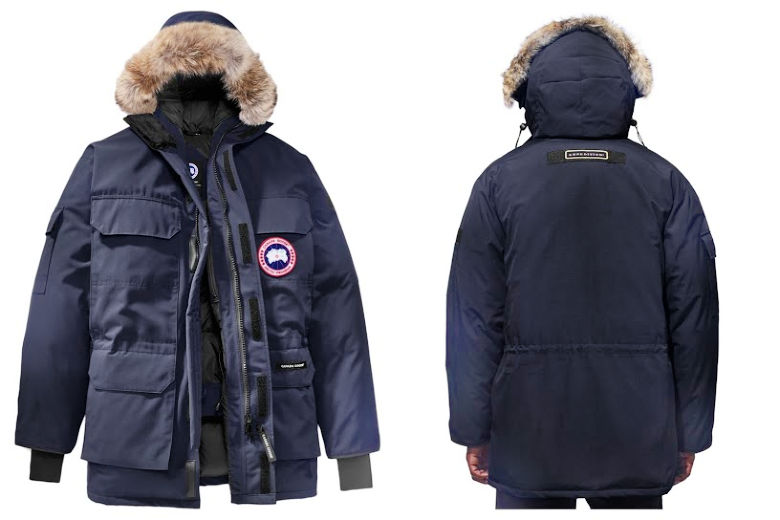
BEST SUB-ZERO DOWN JACKET
Expedition Parka
CANADA GOOSE
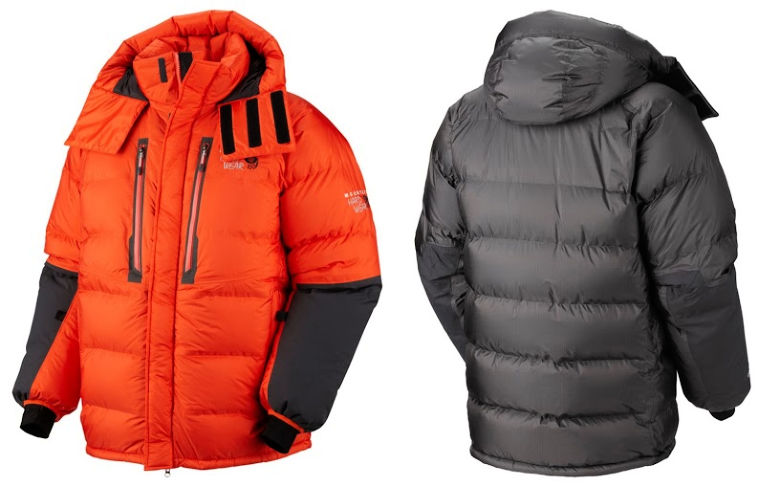
SUB ZERO RUNNER UP
Absolute Zero Parka
MOUNTAIN HARDWARE
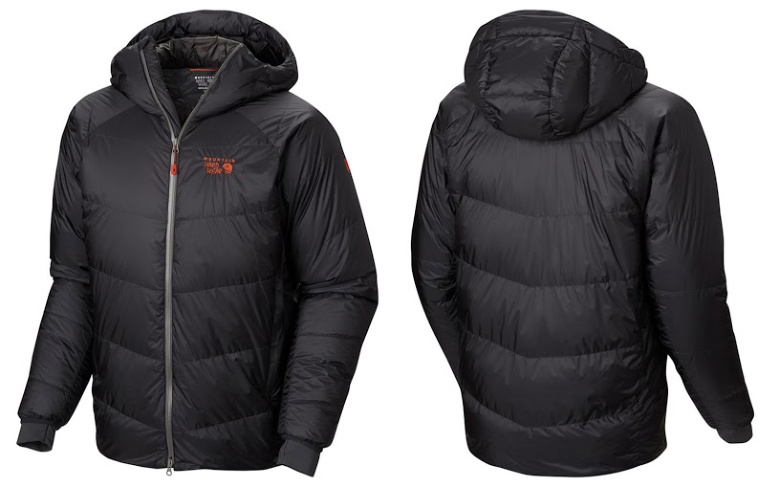
BACKPACKING DOWN JACKET
Nilas Down Parka
MOUNTAIN HARDWARE
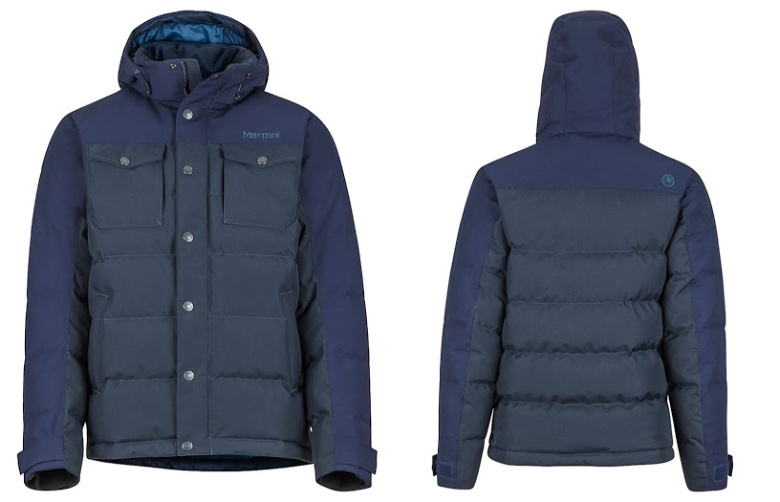
BEST VALUE – MEN’S
Fordham Jacket
MARMOT
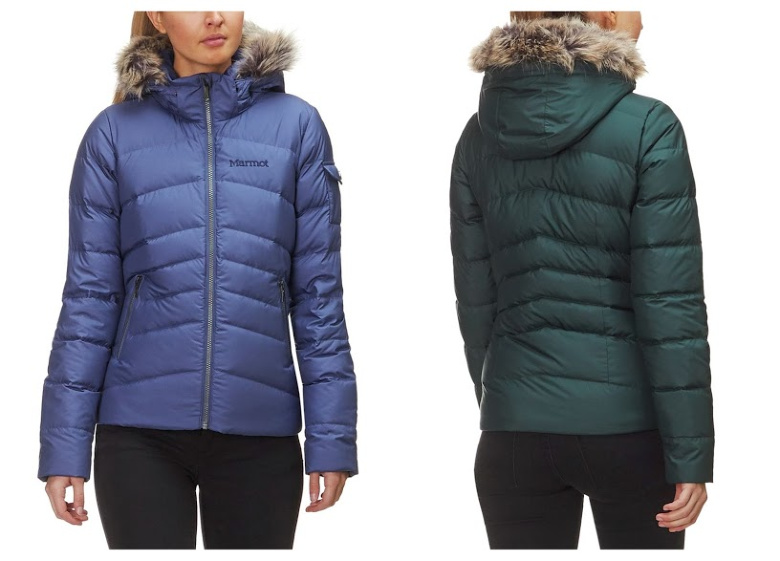
BEST VALUE – WOMEN’S
Ithaca Jacket
MARMOT
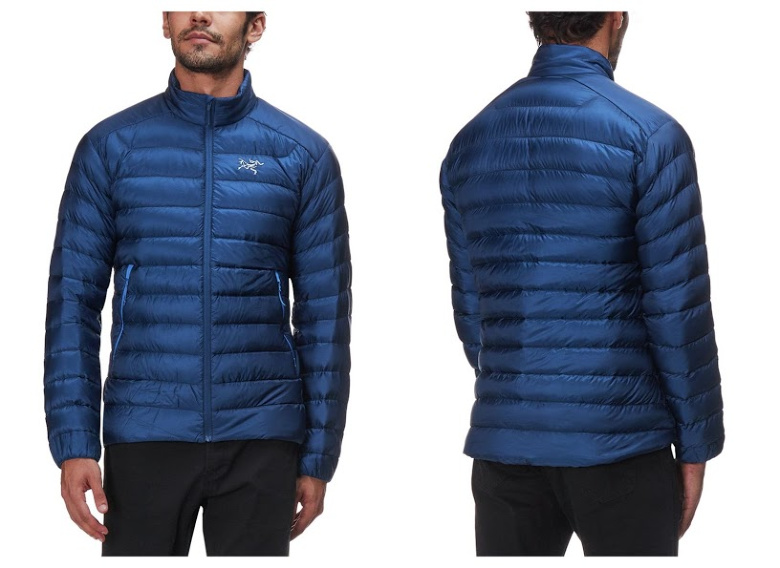
ULTRALIGHT DOWN JACKET
Cerium LT
ARC’TERYX
7 Best Down Jackets: Reviewed
Best Sub-Zero Down Jacket
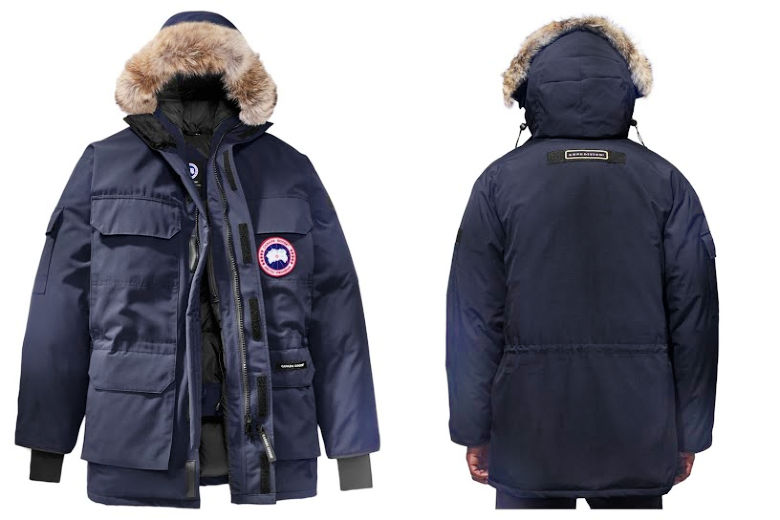
Canada Goose Expedition Down Parka
Best Use: The best down jacket — bar none — for superior warmth in the coldest sub-zero degree conditions
- Fill Material: 625-fill power white duck down
- Shell Material: DWR-coated Arctic Tech 85% polyester, 15% cotton
- Hooded: Yes with removable fur for additional wind chill protection
- Length: Mid-thigh
- Standalone Lower Limit: Sub-zero
Designed for scientists in Antarctica, you won’t find a warmer down jacket than the Canada Goose Expedition. It’s field-tested by Canada Goose to be worn in temperatures down to -22°F!
This jacket extends below the waist to prevent cold air from leaking in while you’re active, and the exterior is Canada Goose’s top-of-the-line Arctic Tech material. That stuff is heavy duty and water-resistant, ensuring you stay warm and dry even in the most adverse conditions.
Pros
Insanely warm, tested down to -22°F but can probably go lower
8 pockets of various sizes and placements
Canada Goose is the best brand available
Cons
Best-in-class jacket comes with a hefty price tag
Weighs 4-5 lbs depending on the size
Runner Up Sub-Zero Jacket

Mountain Hardware Absolute Zero Down Parka
Best Use: For ultimate warmth in potential sub-zero temperatures, especially when you value compressibility
- Fill Material: 800-fill power water-resistant Q. Shield down
- Shell Material: 100% ripstop nylon (2-layer, 30D)
- Hooded: Yes, removable
- Length: Hip
- Standalone Lower Limit: Sub-zero
The Mountain Hardware Absolute Sub Zero Down Parka is one of the highest-rated down jackets you’ll find — almost no one has a bad word to say about it.
With 800-fill power down you’re getting incredible warmth and loft, which also means it’s highly compressible if you need to pack it away.
My biggest gripe with this jacket is its pockets. There are two hand-warmer pockets on the chest that sit directly behind another set of pockets, so basically you have two sets of pockets stacked on top of each other. The drawback here is that the stacked pockets fill up quickly and get bulky. There are two deep pockets on the inside and standard pockets at the hip.
Pros
800-fill power down offers incredible warmth and compressibility
Outer forearms have reinforced material to prevent rips
Hood stays comfortably out of the way and is removable
Cons
Stacked chest pockets offer 4 compartments but get bulky
Fits about a size large if you aren’t layering substantially
Best Backpacking Down Jacket

Mountain Hardware Nilas Down Parka
Best Use: Fantastic option for sub-freezing activities such as backpacking and climbing due to wind resistance and light weight
- Fill Material: 850-fill power Q. Shield down
- Shell Material: AirShield Elite 15D ripstop nylon
- Hooded: Yes
- Length: Hip
- Standalone Lower Limit: Sub-freezing
Designed by speed climber Ueli Steck, the Mountain Hardware Nilas is warm, lightweight, and windproof for cold weather activities where weight and comfort are of importance.
The 850-fill power down is the highest of any on this “best down jacket” list, and the AirShield shell material blocks out cold, whipping winds extremely well. The Nilas weighs just 1 lb 8 oz (varies slightly by size) which makes it much lighter than the two jackets above.
However, it isn’t quite as warm as the above jackets despite the high fill power, and the 15D ripstop material is a little less durable than the other jackets in the top half of this list.
Pros
850-fill power down provides the best warmth per ounce
Lightweight at 1 lb 8 oz with extreme compressibility
High-neck hood and drawstring lock in the warmth
Cuffs make it easy to wear under gloves
Cons
Not as warm as other jackets on the list
15D shell is wind-resistant but less durable
Best For Value – Mens

Marmot Fordham Down Jacket
Best Use: Casual daily use with a more attractive price tag
- Fill Material: 700-fill power water-resistant down
- Shell Material: Sectioned exterior with the following: MemBrain 100% polyester twill; MemBrain 49% nylon, 33% polyester, 18% cotton
- Hooded: Yes, removable
- Length: Hip
- Standalone Lower Limit: Freezing
Winding back to the casual, daily wearers, we land at the Marmot Fordham down jacket. Frankly, while this jacket isn’t quite as good as the Canada Goose MacMillan and Fjallraven Greenland No. 1, the Marmot Fordham is a great bang-for-your-buck option.
The 700-fill power down provides great warmth, and there’s no doubt the sectioned exterior is stylish. The biggest problem is that you’ll probably notice down leaking out after a while.
And while fit is specific to the person, the neck is a little tighter than comparable jackets.
Pros
700-fill power down
Stylish, modern look
High-neck hood and drawstring lock in the warmth
Lots of pockets
Cons
Down tends to leak out after a while
Zipper isn’t very fluid
No hood-cinching features
Best For Value – Womens

Marmot Ithaca Down Jacket
Best Use: Casual daily use with an attractive price tag; also suitable as a mid-layer
- Fill Material: 700-fill power water-resistant down
- Shell Material: 100% water-resistant polyester
- Hooded: Yes, removable with removable faux fur
- Length: Hip
- Standalone Lower Limit: Freezing
The Marmot Fordham above is their top daily option for men. This Marmot Ithaca is their best daily option for women.
The snug fit contours well and helps lock in warmth. The Ithaca also has a removable hood, which in turn has removable faux fur that’s both stylish and functional for blocking the wind.
But this isn’t a very heavyweight jacket. In fact, I wouldn’t want to wear it approaching freezing temperatures. However, it would be a great mid-layer if you want to create your own layering system.
Pros
Micro-fleece cuff lining is extremely comfortable
Removable hood comes with removable faux fur for additional warmth
Lightweight design with 700-fill power down works great as a mid-layer
Cons
Only two hand pockets with no chest pockets
Runs a little small, especially in the shoulders
At just under 1.5 lbs, not suitable for extreme cold
Best Ultra Light Down Jacket

Arc’teryx Cerium LT
Best Use: Best ultralight down jacket in cool, dry conditions or as mid-layer
- Fill Material: 850-fill power white goose down; also has Coreloft synthetic insulation in moisture-prone areas
- Shell Material: Arato 10D 100% nylon
- Hooded: Yes
- Length: Hip
- Standalone Lower Limit: Above freezing
With a thin outer layer and untreated goose down, the Arc’teryx Cerium LT isn’t intended to be an all-purpose outer layer. But checking in at just 10 oz with 850-fill power goose down, it is a fantastic option as a mid-layer under a heavier down parka.
The contoured design is snug, and the articulated shoulder design gives you great range of motion. Arc’teryx also supplemented the high-quality goose down with moisture-resistant synthetic insulation in select areas, such as under the arm.
All-in-all, the Cerium LT is the best mid-layer option on the market.
Pros
850-fill power down gives phenomenal warmth per ounce
Extremely comfortable with a snug fit that doesn’t restrict range of motion
Moisture-resistant synthetic insulation supplements the white goose down in moisture-prone areas
Cons
Not suitable to be worn as an outer layer except in warmer, dry conditions
10D nylon lining isn’t the most durable
Prone to down shedding under heavy usage
Honorable Mention
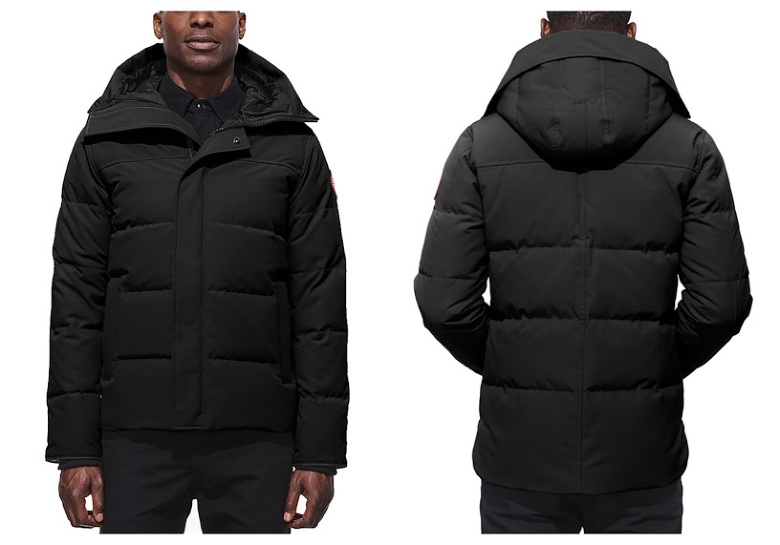
Canada Goose MacMillan Down Parka
Best Use: For casual wear in sub-freezing environments, but not intended for expeditions and hiking or sub-zero survival
- Fill Material: 625-fill power white duck down
- Shell Material: DWR-coated Arctic Tech 85% polyester, 15% cotton
- Hooded: Yes
- Length: Hip
- Standalone Lower Limit: Sub-freezing
The Canada Goose MacMillan is made with the same filling and shell material as our top-ranked Expedition, but this jacket isn’t quite as heavy-duty.
Instead, it’s intended for casual daily wear. Have to wait for the train on a 15°F January morning in the Northeast but don’t want to feel like the Stay Puft Marshmallow Man? The MacMillan is for you.
Fleece-lined pockets provide a warm refuge for your hands. Heavy knit wrist cuffs seal out any cold. The hood is adjustable for your comfort. The MacMillan was made to keep you toasty and snug, but it isn’t designed for extended exposure to sub-zero temperatures or rugged outdoor use.
Pros
Slim fit design is warm and stylish without being bulky
Fleece-lined pockets are insanely comfortable
Stylish, modern look
Cons
Fitted design is not intended for larger individuals or substantial layering
Not designed for rugged outdoor use
Honorable Mention
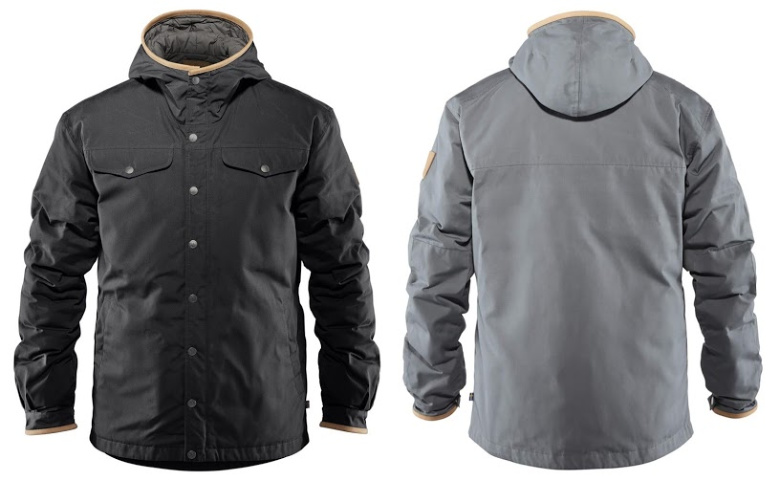
Fjallraven Greenland No. 1 Down Parka
Best Use: Daily casual wear; a less expensive alternative to the Canada Goose MacMillan
- Fill Material: 600-fill power (80% goose down, 20% feather)
- Shell Material: G-1000 Eco blend (65% recycled polyester, 35% organic cotton)
- Hooded: Yes
- Length: Hip
- Standalone Lower Limit: Freezing
My favorite feature of this jacket is its high-neck design. It’s like wearing a protective neck wrap even when the hood is down. And when the hood is up you get a face-hugging barrier fighting back the cold.
My biggest criticism of this jacket is something most would classify as a minor annoyance: the jacket zips up from the left side! I live in the United States, which means I’m used to the opposite. It isn’t the biggest deal at all, but when everything else I own zips up the other way, it can be mildly frustrating.
Pros
Love the high-neck design
Leather trim on cuffs and hood prevents fraying
Stylish, modern look
Cons
Insulation is a down/feather blend
Zipper is on the other side!
Not designed for rugged outdoor use
Honorable Mention
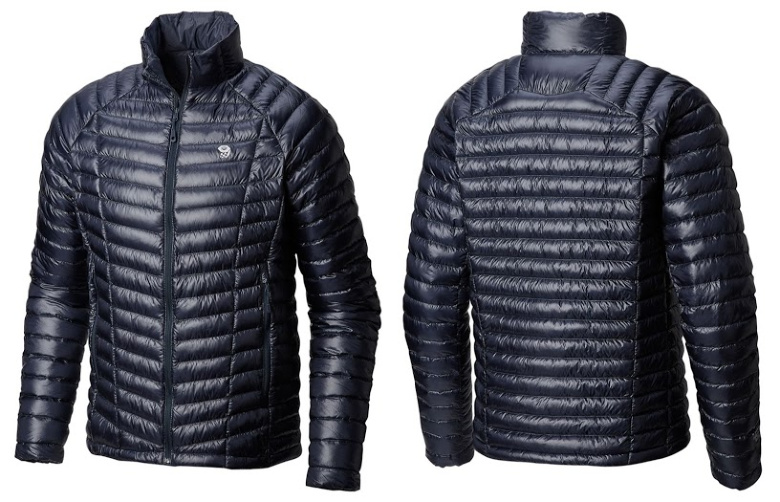
Mountain Hardware Ghost Whisperer Down Jacket
Best Use: Another great ultralight down jacket; mid-layer or standalone piece in cool, dry conditions
- Fill Material: 800-fill power Q. Shield down (90% goose down, 10% goose feather)
- Shell Material: Whisperer 100% 7D x 10D ripstop nylon
- Hooded: Yes (and hood-less available too for both men and women)
- Length: Hip
- Standalone Lower Limit: Above freezing
In the same vein as the Arc’teryx Cerium LT above, the Mountain Hardwear Ghost Whisperer is a mid-layer down jacket that’s even more minimalist. It weighs just 8 oz!
Made with an 800-fill power goose down/feather blend, the Ghost Whisperer has great ounce-for-ounce warmth without being even remotely bulky.
However, with a lighter weight than the Cerium LT and lower fill power down, the Mountain Hardware Ghost Whisperer isn’t quite as warm.
This jacket is also available without the hood if that’s more your style.
Pros
8 oz weight and slim design make it an ideal mid-layer
800-fill power goose down is very high quality (despite being 10% feathers)
Available with and without the hood
Cons
7D x 10D 100% nylon ripstop isn’t durable compared to others here
Slim design means tight fit in the shoulders for broader individuals
Zipper isn’t flimsy but isn’t heavy duty
Honorable Mention
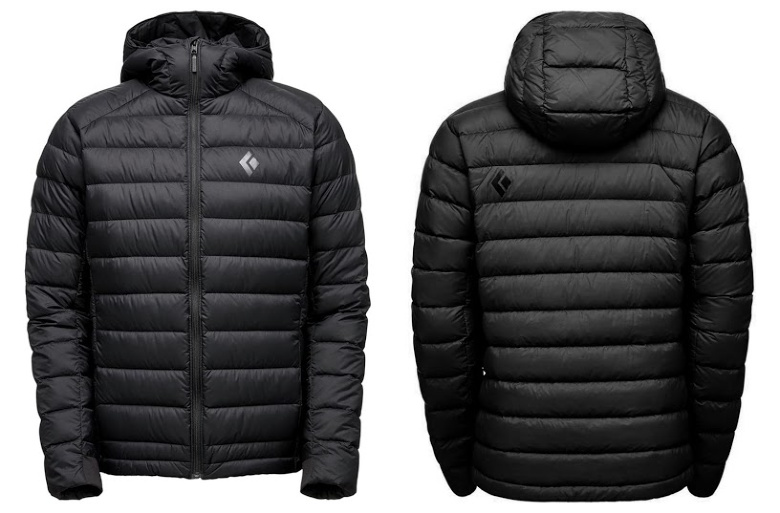
Black Diamond Cold Forge Down Jacket
Best Use: Daily or light expedition use on a budget
- Fill Material: 70% 700-fill power water-resistant goose down; 30% synthetic
- Shell Material: 20D Pertex Microlight 100% nylon
- Hooded: Yes
- Length: Hip
- Standalone Lower Limit: Near-freezing
The Black Diamond Cold Forge is a great option for people looking for a less expensive down jacket. On its own, it’ll keep you comfortable near-freezing temperatures. As part of a layered system, you’ll be able to withstand sub-freezing conditions.
First, the positives. The Pertex Microlight shell is 100% nylon and engineered for reduced weight while still maintaining solid 20D strength. Well-designed underarm gussets give you free range of motion, and a hemline drawcord around the waist cinches you in for maximum heat retention.
On the downside, the wrists don’t cinch down and sort of just hang over your hands, but there is an internal elastic that closes around your wrist. It’s also a 70/30 down/synthetic blend so it doesn’t pack down as well as 100% down jackets.
While I’m not a tall, lanky person, many people who fit that description have said this jacket is great for their longer bodies.
Pros
Exterior shell has good durability per unit weight
Well-designed arms don’t restrict range of motion
Suitable for taller, lankier people
Cons
Not suitable for sub-freezing conditions
Sleeves hang long over the hands, which may be bothersome
30% synthetic blend vs the many 100% down jackets on this list
Honorable Mention
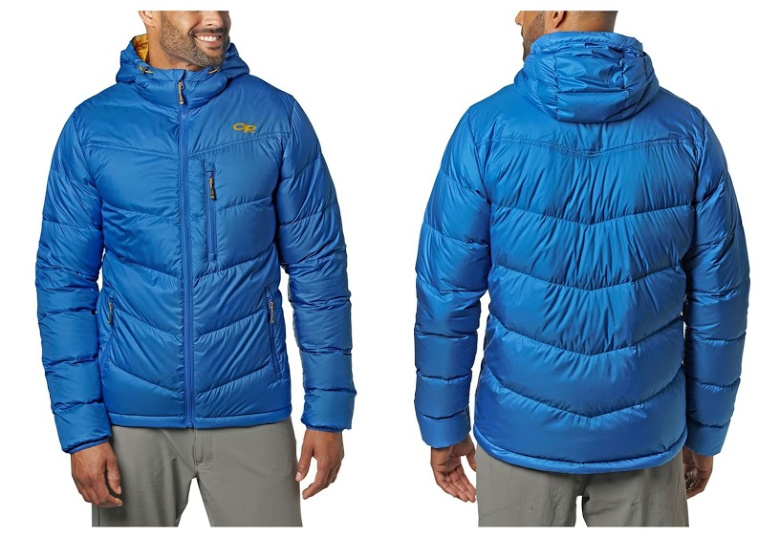
Outdoor Research Transcendent Down Jacket
Best Use: Daily or light expedition use on a budget
- Fill Material: 650 fill-power goose down
- Shell Material: 20D 100% nylon
- Hooded: Yes
- Length: Hip
- Standalone Lower Limit: Near-freezing
Any “best down jacket” list is going to come up short because what does “best” really mean? I’ve tried to assemble this list from most to least warm with higher quality materials a tiebreaker among similar jackets.
So here at #11 we find the Outdoor Research Transcendent down jacket. This jacket’s 650-fill power down is lower than most we’ve seen on this list, and that means you get a puffier jacket. Like nearly every jacket above, you’ll be fine down to about freezing temperatures but not much below that.
Whereas many of the above jackets have had a fitted design, this one is more barrel-shaped, which makes it ideal for thicker individuals.
Pros
Great price point
2 hip pockets plus a 3rd left-breast storage pocket and 2 huge inner pockets
Smooth, snag-free zippers
–
Cons
The shell isn’t especially tough
Not as warm as other jackets listed, so you’ll probably need to layer
Down insulation in the arms is a little lacking
Honorable Mention
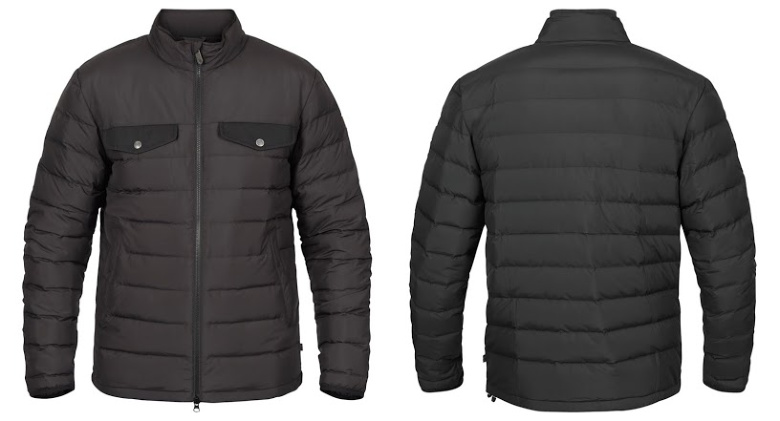
Fjallraven Greenland Down Liner
Best Use: In above-freezing conditions for backpacking, hiking, or casual activity; also as a mid-layer in sub-freezing conditions
- Fill Material: 80% 600-fill power water-resistant goose down, 20% feather
- Shell Material: 100% nylon polyester
- Hooded: No
- Length: Hip
- Standalone Lower Limit: Above freezing
Just because the Fjallraven Greenland Down Liner is ranked 12th on this list doesn’t mean I hate this jacket. I actually love it!
Remember, I’m trying to sort this list from most to least warm, and this thing is just a lightweight liner. But Fjallraven makes some high-quality, durable gear; their Greenland No. 1 jacket ranks 5th on this list.
This jacket weighs just over 1 lb and has a great fitted design, so it isn’t too bulky under a larger jacket. The men’s jacket has two chest pockets vs the single chest pocket for women, but there’s still plenty of well-positioned storage.
While it is an awesome option as a mid-layer, it can also be used as a standalone jacket in warmer conditions north of freezing. With water-resistant down you’ll be protected in moist conditions. (Just don’t wear it out in persistent rain.)
Pros
Soft jersey material in the sleeves for plush fit and feel
Tons of pockets and storage
Fitted design is great as a standalone or mid-layer
Cons
Isn’t super lofty due to 600-fill power down and 20% feather blend
Zipper is on the other side!
Honorable Mention
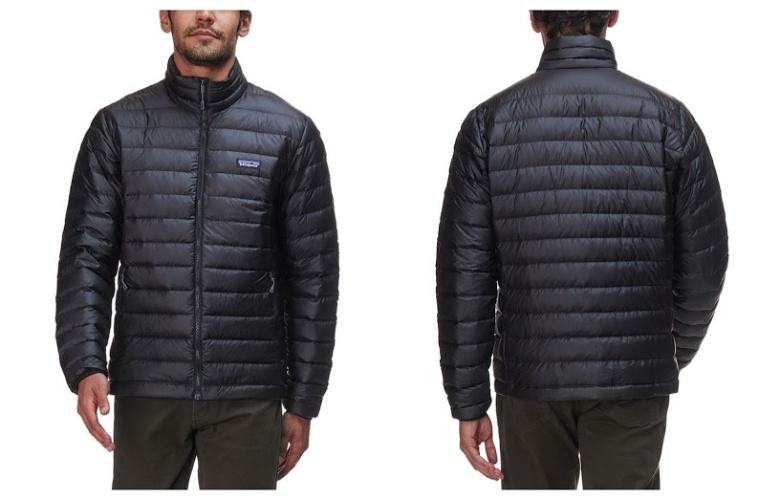
Patagonia Down Sweater Jacket
Best Use: Occasional, lightweight, or casual use in near-freezing conditions
- Fill Material: 800-fill power goose down
- Shell Material: 20D x 30D 100% recycled water-resistant ripstop nylon
- Hooded: No
- Length: Hip
- Standalone Lower Limit: Near-freezing
Wow, 800-fill power goose down? This jacket must be insanely warm! Well, not quite. While it is highly compressible with such lofty down, the fill weight is pretty low. All-in-all, this jacket weighs just 13 oz (depending on the exact size).
The other main issue is its questionable durability. Many users have reported fraying cuffs, deteriorating seams, and leaking down.
However, you could probably buy a few of these jackets for the cost of many of the above options. Now, I’m a quality over quantity guy and am willing to pay up for better quality construction, but that requires a lot of saving (or some hefty credit card balances).
If you just need some affordable warmth and don’t want to do anything too strenuous, you’ll be fine with the Patagonia Down Sweater.
Pros
Soft jersey material in the sleeves for plush fit and feel
Tons of pockets and storage
Fitted design is great as a standalone or mid-layer
Cons
Isn’t super lofty due to 600-fill power down and 20% feather blend
Zipper is on the other side!
Honorable Mention
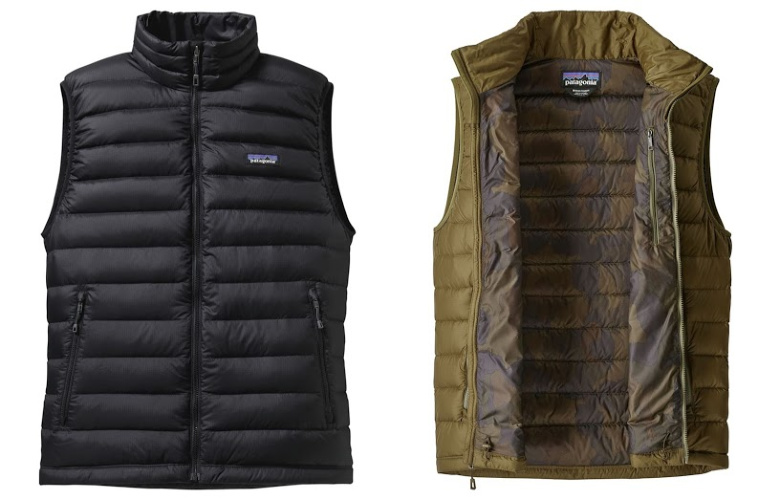
Patagonia Down Vest
Best Use: As part of a lightweight layer system or some core warmth in 50°F-60°F conditions
- Fill Material: 800-fill power goose down
- Shell Material: 20D x 30D 100% recycled ripstop nylon water-resistant
- Hooded: No
- Length: Hip
- Standalone Lower Limit: Well above freezing
Cut the sleeves off the 13th-ranked Patagonia Down Sweater and you have the Patagonia Down Vest!
Vests are not standalone items in adverse conditions (obviously), but they can be an important part of a light layering system. Combine this vest as an outer layer over the Fjallraven Greenland Down Liner and BOOM — you have a very warm down system that can be worn three ways:
- Vest only in 50°F-60°F temperatures
- Liner only in 30°F-50°F temperatures
- Vest & liner in sub-freezing conditions
Versatility is hugely important, and with both a vest and liner you can be covered from sub-freezing to springtime temperatures.
Pros
800 fill-power down is supremely compressible
Recycled shell material and traceable goose down are environmentally sustainable
Can be a crucial part of a great layering system
Cons
Down is not treated to be water-resistant
Construction quality is lacking; prone to leaking
Types of Down Jackets
By “types” in this context I want to talk about style, namely:
- Down vests
- Down sweaters
- Ultralight down jackets
- Mid-weight down jackets
- Heavyweight down jackets
Down Vests
Down vests are any kind of down jacket that doesn’t have sleeves. The biggest pro to a down vest versus any of the other down jacket types is the flexibility it provides.
Want some body warmth without feeling like you’re in a Dominoes pizza warmer? Wear the vest without any other down long sleeve. Need more warmth? Wear the vest over a down sweater or ultralight jacket.
My goal when choosing the best gear is to get high-quality stuff that gives me maximum flexibility. Owning multiple smaller pieces of clothing that can be worn separately or combined for more warmth and protection is a great way to remain flexible without adding too much weight.
Down Sweaters
Here’s where things start to get a bit…fuzzy. (No, not like that itchy sweater Grandma knit you 12 years ago.)
A down sweater is really just a lighter version of a down jacket that doesn’t provide as much insulation.
This thread on Backpacking Light does a good job discussing down sweaters versus down jackets.
The summary? Down sweaters don’t have any universal set of features. Instead the term is more of a marketing phrase to help customers quickly identify the type of usage for the garment. Ultimately, you should evaluate the sweater/jacket based on its materials, features, and intended usage.
Ultralight Down Jackets
An ultralight down jacket is basically anything that can be packed away for a minimalist experience.
Generally, ultralight jackets are made with high-quality down with a high fill power, because you get more ounce-for-ounce insulation. The loftiness of this high fill power down also makes the jacket more compressible.
Despite those pros, ultralight jackets won’t be able to match the insulation power of heavier down jackets, assuming the same type and fill power of down. You may also lose some weather resistance and durability on the jacket’s exterior.
But as I’ve mentioned a couple times already, the lines between all these types of down jackets are blurred. Evaluate the specs of each jacket to decide whether the ultralight your eyeing is really the right type for you.
Mid-Weight Down Jackets
In general, a mid-weight down jacket will be heavier and bulkier than an ultralight, but not necessarily warmer if the down is lower quality!
On the flip side, mid-weight jackets tend to be less bulky with less insulating power than the heavyweight big boys. (But again, not a universal rule.) Check the specs of each model you’re comparing to see if it meets your needs regardless of what “type” the manufacturer calls it.
Heavyweight Down Jackets
The biggest, baddest down jackets around, these are the heavy-duty big boys with a lot of heft, thicker outer shells, and (theoretically) a lot of insulating power.
Looking to go for a camping trip in sub-freezing temperatures? You probably want a heavyweight down jacket, assuming you’re OK to travel with the added bulk.
How to Choose the Best Down Jacket
I think the jackets listed above are the best down jackets out there, but making any “best of” list is rife with peril! What’s best for me may not be best for you.
Use the list above as a jumping off point for the respective brands and product lines. Use the 10 tips below to dial in the best down jacket for your needs.
- Fill Power
- Fill Weight
- Jacket Type
- Natural vs Synthetic Down
- Hydrophobic Down and Durable Water Repellents
- Seam Construction
- Overall Jacket Weight
- Compression
- Jacket Fit
- Hood or No Hood?
Fill Power
Fill power is the most important thing to know about the down jacket you’re buying, so what is it?
Let’s let the fine folks at REI tell us!
Fill power is a number that indicates the relative quality of down. The number comes from a lab test that measures how many cubic inches of loft one ounce of that down fill produces. Higher fill power numbers indicate greater loft and insulating efficiency.KEN KNAPP, REI
Well done, Ken.
So one ounce of 600-fill power down will take up 600 cubic inches. One ounce of 700-fill power down will take up 700 cubic inches.
Seems counter-intuitive, right? Wouldn’t you think that denser down would keep you warmer? Well, the key to down’s insulating power is actually in the air pockets the down provides. Fluffier down with a higher fill power has more of these micro-air pockets, which provides better insulation efficiency.
Ken also goes on to say that a higher fill power doesn’t necessarily mean a warmer jacket. There are a ton of other factors that go into a jacket’s overall insulation, such as fill weight, type of down, etc. We’ll explore those below.
Fill Weight
Fill power is the oft-cited specification that down jacket providers tell you, but what’s equally important is fill weight.
Let’s say you’re deciding between two down jackets:
- Jacket A has 12 oz of 900-fill power down
- Jacket B has 24 oz of 450-fill power down
Which jacket do you think is warmer?
(This isn’t a trick question.)
Answer: All things equal, they’re equally warm!
Note: I say “all things equal” because a down jacket’s warmth is still more than just fill power and fill weight. You also have to consider how snugly the jacket fits, what the outer shell is made of, whether it has baffles (I’ll explain these below), and more!
In general it’s correct to say that Insulation = Fill Power x Fill Weight. (Again, all else equal.)
Unfortunately, a jacket’s fill weight often is harder to find. Many manufacturers don’t publish it on their product pages.
Seam Construction (e.g. Baffles vs No Baffles)
Seam construction is an oft-overlooked but highly important part of choosing the best down jacket. Basically, there are two types of seams:
- Sewn-through seams
- Baffled seams
What the heck are baffles? Take a look at my expertly hand-drawn comparison of the two types below:
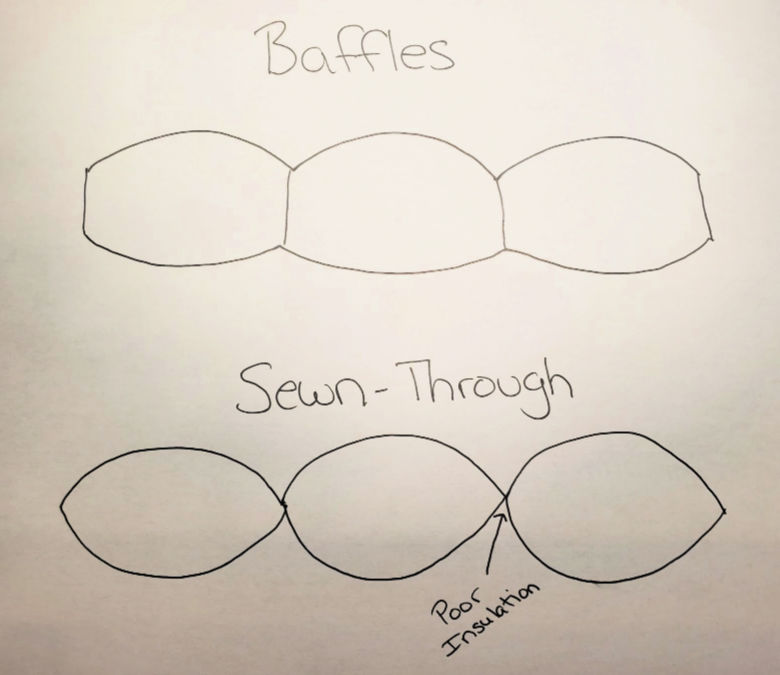
Sewn-through seams are when the jacket is stitched directly through the outer layer to the inner layer. The result is a ton of areas where there’s zero down, which means inferior insulation.
Down jackets with baffles have walls in between the layers, which create pockets filled with down. These pockets have two benefits:
- Prevent the down from clumping up in different areas
- Have no sewn-through seams to compromise insulation
If you want superior warmth, you want baffles.
Overall Weight
Earlier I mentioned fill weight, which is the weight of the insulation used. This category is overall jacket weight, which includes every other component — outer shell, zipper, overall jacket size, etc.
What’s a good weight? That depends on your preferences and intended uses. Here are some examples of when overall weight will be a factor:
- Bigger people probably need bigger (and heavier) jackets.
- Smaller people probably can purchase smaller (and lighter) jackets.
- Minimalist hikers/campers may want something lighter.
- Synthetic down weighs more per unit insulation than natural down.
- Higher fill power down will provide better insulation per ounce.
What’s your intended use? What kind of weight do you need?
Compression
This is all about packing and convenience.
High fill power natural down has a lot of loft, which means it has a lot of air pockets that can be compressed if you need to store the jacket away. Lower fill power down and synthetic down don’t have as much loft, which means less compression and heavier jackets.
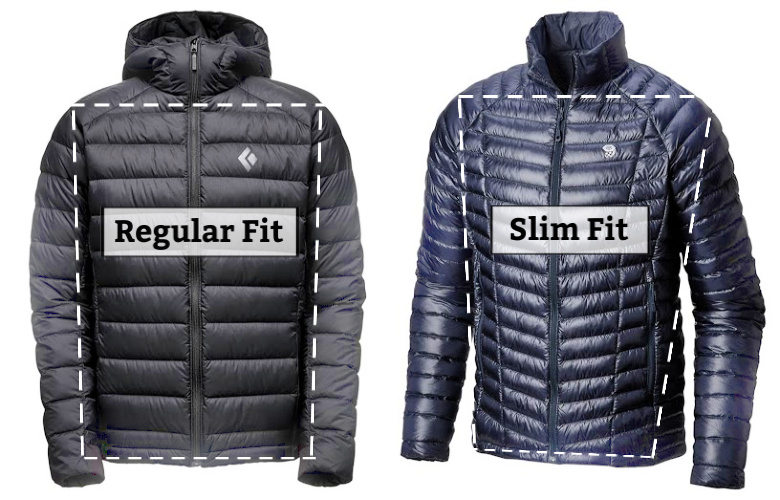
Jacket Fit
How should a down jacket fit for optimal insulation?
- Close to the body, but not too tight; slightly roomy is best
- Allow enough room for any planned undergarments
- Should still maintain full range of motion
- Long enough to cover your waist in seated/bending positions
- Sleeves long enough to cover your wrists when reaching
- Elastic waist/wrists should help keep warmth in even if the jacket is slightly oversized
As with any garment, different brands have different fits.
To Hood or Not to Hood?
That is the last question.
Hoods give you three major benefits:
- Extra insulation
- Extra efficiency
- Extra protection from wind
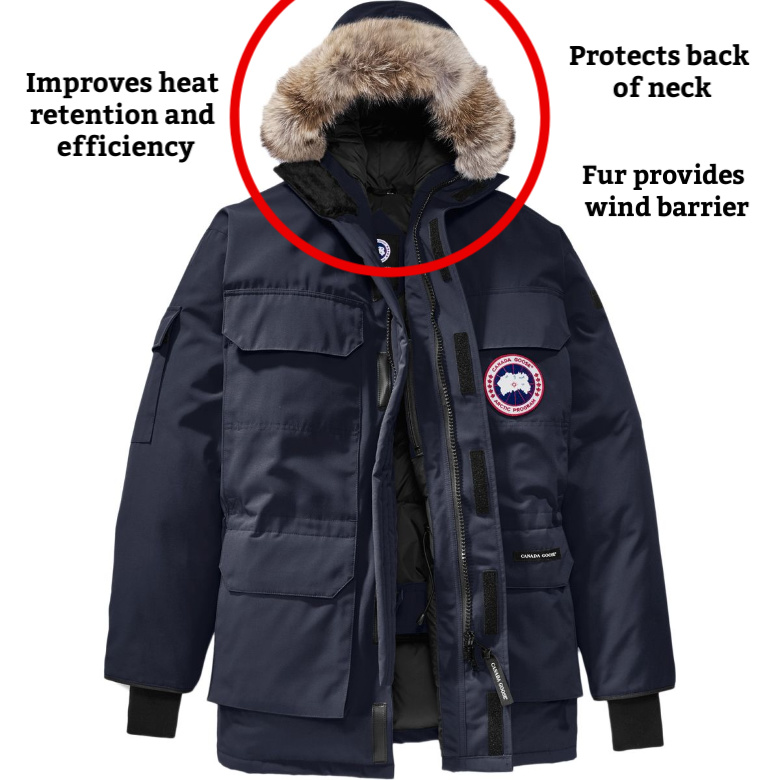
Because the hood connects directly to the back of the jacket and wraps around your head, it’s tougher for cold air to get in. Plus, the hood keeps your neck warm unlike just wearing a winter hat.
All-in-all, I love down jackets with hoods. You just can’t beat the convenience of having that extra warmth for the back of your neck and ears whenever you need it.
If you’re in the market for a hooded down jacket, consider the following features:
- Drawstrings to tighten and seal in the warmth
- Overall fit and shape
- How much added weight/volume the hood is
- Whether the hood is removable
But a hood isn’t always a good idea! I can think of two instances:
- Skiing
- When the down jacket is a mid- or under-layer (personal preference)
But aside from those two situations, I think the hood is always preferable. Your mileage may vary.
Natural Down vs Synthetic Down Jackets
When you’re shopping for the best down jacket, you’ll probably come across two different types of down:
- Natural down, such as duck or goose down
- Synthetic down
The distinction between the two is crucially important to know. At a high level, here’s the comparison:
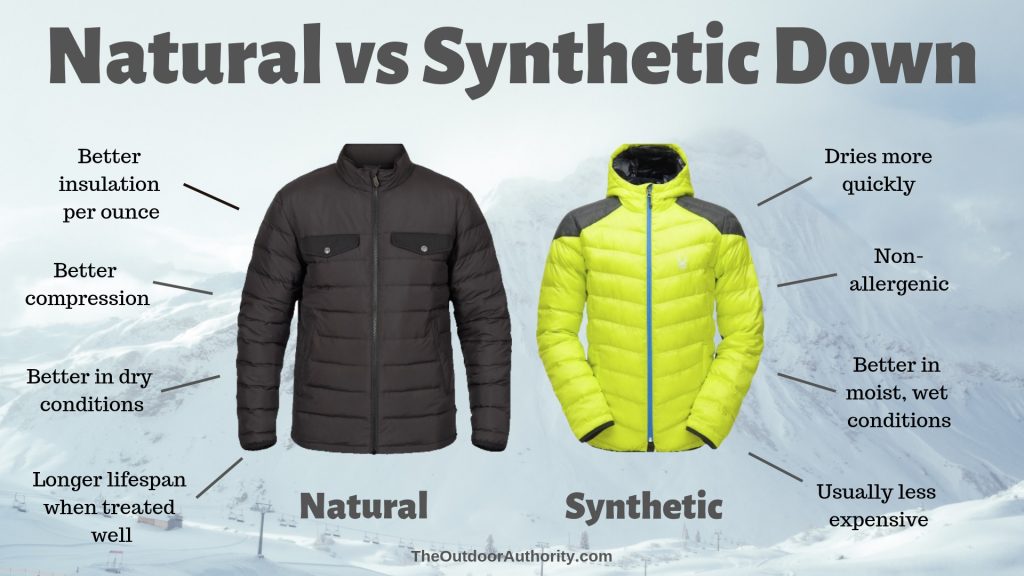
Natural Down
Best For: Dryer conditions when you need more warmth per unit weight.
- High-quality down jackets can be much lighter for the same insulation power
- Compress more easily, especially high fill power down
- Better insulation in dry conditions
- Longer lifespan when treated well
Synthetic Down
Best For: Moister conditions when you’re OK sacrificing some warmth or weight; also when you’re on a budget!
- Dry more quickly
- Non-allergenic
- Better insulation in wetter conditions (except compared to hydrophobic natural down, which is discussed below)
- Usually less expensive
Suggested Reading: Last Guide to Down vs Synthetic Insulation That You’ll Ever Need
Hydrophobic Down and Durable Water Repellents
Natural down’s biggest drawback is its poor performance in moist/wet conditions. Basically, wet down loses its loft — the tiny air particles in between the feathers — that give it superior powers of insulation.
To combat this, manufacturers have recently developed hydrophobic down, otherwise known as water-resistant down. Hydrophobic down is treated with a synthetic coating to prevent the down from collapsing.
The big question: Does hydrophobic down actually work?
Gizmodo put it to the test with just about the most extreme real world example imaginable: jumping into a frozen lake in a hydrophobic down jacket.
After a full minute submerged, the brave (and insane?) tester emerged from the water with a jacket that wasn’t much heavier than before he jumped in the frozen lake. The hydrophobic down worked!
My two cents? If you have the opportunity (and budget) for natural down, go with the hydrophobic stuff. While you probably won’t be jumping/falling into any frozen lakes, you’ll still be protected against rainfall, sweat, and condensation — all of which are the enemy of regular natural down.
Down Jackets FAQ
Is Down The Best Jacket For Winter?
Yes, down is the overall best insulation choice for winter jackets. If your budget allows, we also recommend opting for hydrophobic natural down which provides warmth even when it’s wet.
Is Down The Warmest in Jackets?
Yes, down is the warmest in comparison to synthetic blendss and is also extremely light and compressible, which makes it an optimal choice for jacket insulation.
Is 800 Fill Down Warmer Than 600 Fill Down?
Yes, all other things being equal the higher the down rating the warmer it is.

